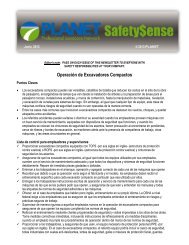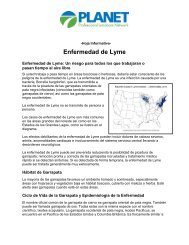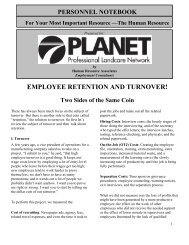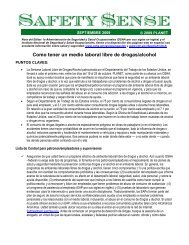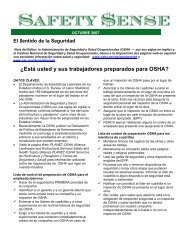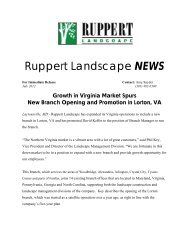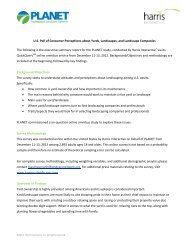Economic Impacts of the Green Industry in the - Urban Forest ...
Economic Impacts of the Green Industry in the - Urban Forest ...
Economic Impacts of the Green Industry in the - Urban Forest ...
Create successful ePaper yourself
Turn your PDF publications into a flip-book with our unique Google optimized e-Paper software.
* Values expressed <strong>in</strong> 2004 dollars (GDP Implicit Price Deflator).<br />
Note: Miss<strong>in</strong>g values for some states were estimated at national average. Percentage <strong>of</strong> landscape services for tree care: 27.05%.<br />
Sources: Census <strong>of</strong> Agriculture or ERS Floriculture & Nursery Outlook (nursery output); National Nursery Survey, 2004 (percentage <strong>of</strong><br />
nursery output for trees); 2002 <strong>Economic</strong> Census (share <strong>of</strong> landscape services for tree care).<br />
In <strong>the</strong> lead<strong>in</strong>g states <strong>of</strong> California and Florida, tree production represented 19 and 18 percent, respectively, <strong>of</strong> total<br />
nursery and greenhouse output. For California, output impacts <strong>of</strong> urban forestry were <strong>in</strong> excess <strong>of</strong> $3 Bn,<br />
employment impacts were 37,769 jobs, and value added impacts were $2.11 Bn, while <strong>in</strong> Florida, output impacts<br />
were $1.55 Bn, employment impacts were 21,946 jobs, and value added impacts were $1.12 Bn. O<strong>the</strong>r states with<br />
large value added impacts for urban forestry <strong>in</strong>cluded Texas ($757 Mn), Ohio ($633 Mn), Pennsylvania ($621<br />
Mn), North Carol<strong>in</strong>a ($602 Mn), Ill<strong>in</strong>ois ($568 Mn), Oregon ($537 Mn), New Jersey ($470 Mn) and Maryland<br />
($445 Mn).<br />
O<strong>the</strong>r <strong>Economic</strong> Benefits <strong>of</strong> <strong>Urban</strong> <strong>Forest</strong>ry<br />
In addition to <strong>the</strong>se impacts on nursery production and landscape services, trees and landscap<strong>in</strong>g have important<br />
effects on residential and commercial property values. Most <strong>of</strong> <strong>the</strong> studies reported <strong>in</strong> <strong>the</strong> literature have evaluated<br />
variation <strong>in</strong> sales prices for properties <strong>in</strong> relation to a variety <strong>of</strong> <strong>in</strong>fluenc<strong>in</strong>g variables, such as location, build<strong>in</strong>g<br />
size, neighborhood features, transportation access, etc. These <strong>in</strong>vestigations are generally known among<br />
pr<strong>of</strong>essional economists as “hedonic pric<strong>in</strong>g” or “revealed preference” studies. Typically, <strong>the</strong> studies are<br />
conducted with<strong>in</strong> a limited geographic area to control for dom<strong>in</strong>at<strong>in</strong>g variables such as <strong>in</strong>come or demographic<br />
composition. Payne (1973), who was one <strong>of</strong> <strong>the</strong> first researchers <strong>in</strong> this area, reported a 7 percent premium on<br />
average for <strong>the</strong> market value <strong>of</strong> a s<strong>in</strong>gle-family residence due to <strong>the</strong> presence <strong>of</strong> “arborescent vegetation” (trees).<br />
The premium ranged from 5 to 15 percent. However, <strong>the</strong>re was a ceil<strong>in</strong>g on <strong>the</strong> positive effect <strong>of</strong> trees; beyond<br />
more than about 30 trees on a residential lot or more than 67 percent wooded cover, values were reduced. A<br />
study conducted <strong>in</strong> Manchester, CT found that good tree cover <strong>in</strong>creased sale prices for homes by 6 to 9 percent<br />
(Morales, Boyce and Favretti, 1976). Also, Siela and Anderson (1982) reported that new homes on tree-planted<br />
lots commanded 7 percent higher prices than bare lots.<br />
A study <strong>of</strong> 800 s<strong>in</strong>gle-family home sales dur<strong>in</strong>g 1978-80 <strong>in</strong> A<strong>the</strong>ns GA concluded that <strong>the</strong> presence <strong>of</strong> trees <strong>in</strong> <strong>the</strong><br />
front yard added 3 to 5 percent to <strong>the</strong> sales price (Anderson and Cordell, 1985). In a second study by <strong>the</strong> same<br />
authors <strong>in</strong> a lower-priced neighborhood also found a 3.5 to 4.5 percent premium <strong>in</strong> sales value for homes with<br />
<strong>in</strong>termediate to large trees (Anderson and Cordell, 1988). It was fur<strong>the</strong>r reported that each evergreen or broadleaved<br />
tree contributes about $319 to $376, respectively, <strong>in</strong> value to <strong>the</strong> home. In a study <strong>of</strong> 269 s<strong>in</strong>gle-family<br />
house sales with an average price <strong>of</strong> $93,272, it was found that <strong>the</strong> presence <strong>of</strong> mature trees contributed about 2<br />
percent to <strong>the</strong> home value (Dombrow, Rodriguez and Sirmans, 2000). A study by Henry <strong>in</strong> 1999 estimated <strong>the</strong><br />
contribution <strong>of</strong> <strong>the</strong> quality <strong>of</strong> landscap<strong>in</strong>g to house prices for a sample <strong>of</strong> 218 home sales <strong>in</strong> <strong>Green</strong>ville, SC from<br />
1996 to 1997. For homes with <strong>the</strong> same square footage and o<strong>the</strong>r house characteristics, sell<strong>in</strong>g prices were six to<br />
seven percent higher if landscap<strong>in</strong>g was judged excellent ra<strong>the</strong>r than good. The price premium obta<strong>in</strong>ed by<br />
upgrad<strong>in</strong>g landscap<strong>in</strong>g from average to good was approximately four to five percent. F<strong>in</strong>ally, <strong>in</strong> perhaps <strong>the</strong> most<br />
sophisticated <strong>in</strong>vestigation <strong>of</strong> its k<strong>in</strong>d to date, DeRosiers, Therialut, Kestens and Villeneuve (2002) exam<strong>in</strong>ed 760<br />
s<strong>in</strong>gle-family home sales <strong>in</strong> Quebec, Canada, between 1993 and 2000. It was found that a positive differential <strong>of</strong><br />
tree cover between a property and its immediate neighborhood raised <strong>the</strong> property value by about 0.2 percent for<br />
each percentage po<strong>in</strong>t difference. The higher <strong>the</strong> proportion <strong>of</strong> retired people <strong>in</strong> <strong>the</strong> neighborhood, <strong>the</strong> more<br />
beneficial was <strong>the</strong> presence <strong>of</strong> trees, while it was less so for neighborhoods with a predom<strong>in</strong>ance <strong>of</strong> people aged<br />
45-64. For small homes (bungalows and cottages), a high percentage <strong>of</strong> ground covers and landscape features<br />
such as flower beds contributed more value than did a tree canopy. This <strong>in</strong>vestigation also found that an excessive<br />
tree cover may negatively impact values, consistent with earlier studies.<br />
Well-ma<strong>in</strong>ta<strong>in</strong>ed trees also <strong>in</strong>crease <strong>the</strong> “curb appeal” <strong>of</strong> properties. Research compar<strong>in</strong>g sales prices <strong>of</strong><br />
residential properties with different tree resources suggests that people are will<strong>in</strong>g to pay 3 to 7 percent more for<br />
properties with tree resources versus few or no trees. One <strong>of</strong> <strong>the</strong> most comprehensive studies <strong>of</strong> <strong>the</strong> <strong>in</strong>fluence <strong>of</strong><br />
trees on residential property values was based on actual sales prices and found that each large front-yard tree was<br />
64



